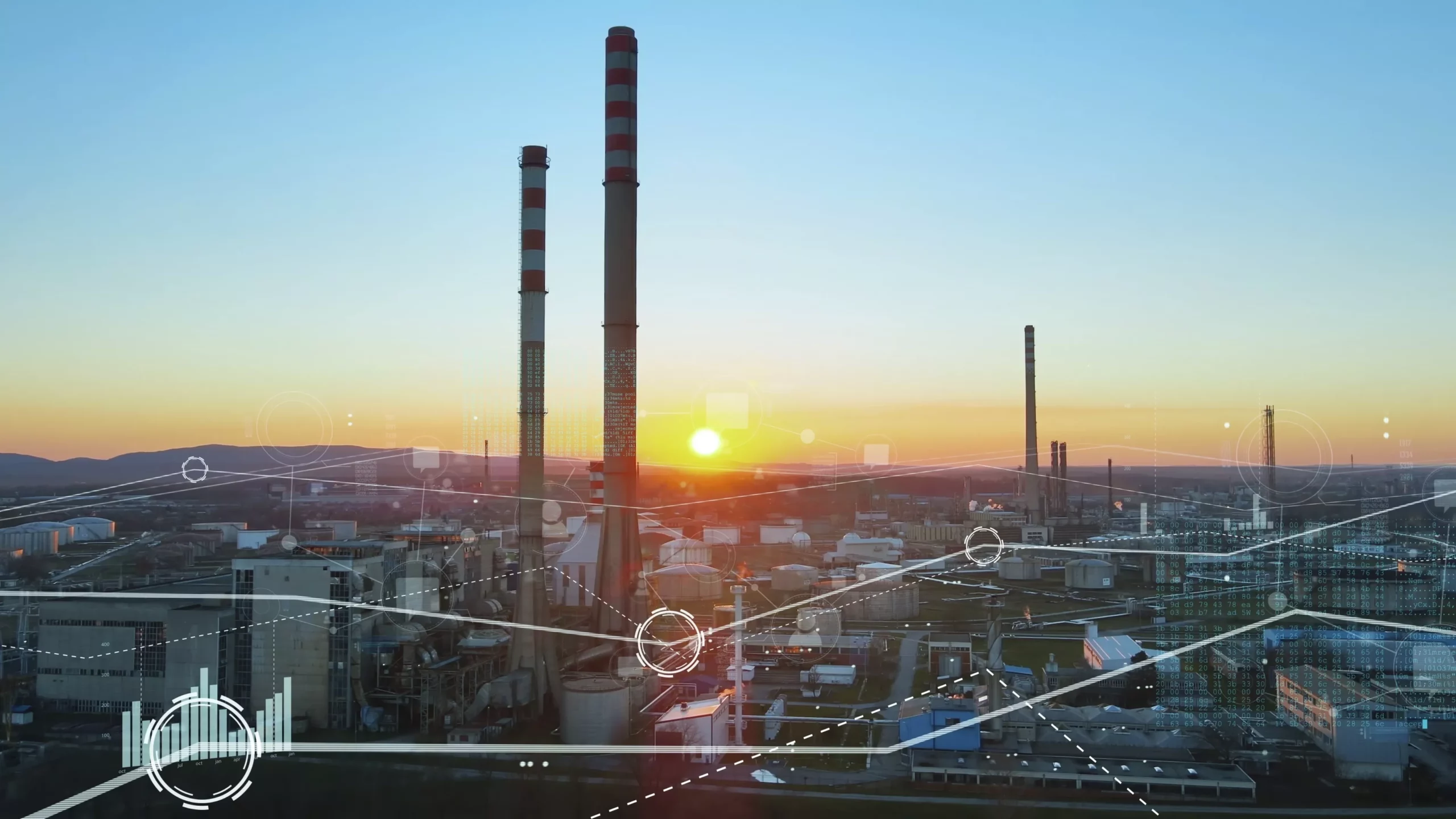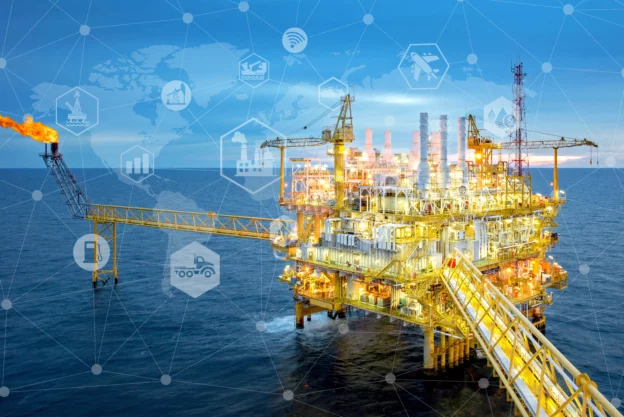Introduction
In a context where sustainability has become the main objective of industries, the Oil & Gas sector faces significant challenges. Historically considered as one of the main drivers of environmental and energy issues, this sector is at a crucial moment of transformation towards digital technologies in order to accelerate the path towards a more sustainable and responsible operation.
From artificial intelligence to blockchain to the Internet of Things (IoT) to advanced data analytics, these digital tools are redefining operational efficiency, resource management and reduced environmental impact. In this analysis, we will address the adoption of digital technologies, not only as a business survival issue, but as a necessary strategy to lead the industry towards a greener and more sustainable future.
Current context of the Oil & Gas sector
The Oil & Gas sector is at a critical crossroads, facing a triad of challenges that demand immediate and effective solutions. First, environmental and sustainability challenges are more pressing than ever. The industry, historically associated with high carbon emissions and considerable ecological impact, is under global scrutiny to transform its operations to mitigate its environmental footprint. This ranges from reducing greenhouse gas emissions to water management and minimizing spills and pollution.
Simultaneously, regulatory and public pressure has escalated. Governments around the world are imposing stricter regulations on emissions and sustainability, while consumers and shareholders are demanding greater transparency and accountability. This dual pressure acts as a catalyst for change, forcing companies to adopt greener and more sustainable practices in order to maintain their license to operate.
Finally, the need for efficiency and cost reduction has never been more critical. In a market characterized by volatile oil and gas prices, optimizing operations to be more efficient and less costly is essential for long-term survival and success. This includes finding ways to optimize exploration, production, and distribution while reducing environmental impact.
Faced with these challenges, the Oil & Gas sector is turning to advanced digital technologies not only as a tool to improve operational efficiency and reduce costs, but also as an essential means to achieve its sustainability goals and respond effectively to regulatory and public expectations.
Emerging digital technologies in the Oil & Gas sector
The progress of the digital technologies are changing the sector Oil & GasThe new program provides powerful tools to meet today’s challenges and open up new goals towards efficiency and sustainability. Among these technologies, four stand out for their transformative impact: the Artificial intelligence (AI) and Machine Learning (ML), the Internet of Things (IoT), blockchain and advanced Big Data analytics.
- Artificial Intelligence and Machine Learning: These new technologies are optimizing operations in the sector in previously unimaginable ways. From predictive analysis for equipment maintenance, thus minimizing downtime and maximizing efficiency, to exploration and production optimization through oilfield modeling and simulation. These technologies enable more informed and faster decision making, which is crucial in such a dynamic and competitive environment.
- Internet of Things (IoT): IoT connects devices and sensors throughout the value chain, providing real-time data on equipment status, working conditions and operational processes. This connectivity allows constant monitoring and more precise control of operations, leading to significant improvements in safety, efficiency and reduced operating costs.

- Blockchain for transparency and traceability: Provides a secure and transparent platform for recording transactions and operations, improving traceability and reducing the potential for fraud and errors. In the Oil & Gas sector, this translates into greater trust between the parties, contract optimization, and efficient monitoring of the supply chain, from extraction to the end consumer.
- Big Data and Advanced Analytics: Data analytics provides deep insights into operational patterns, market trends and consumer behaviors, enabling more strategic planning, more efficient operations and proactive risk management.
The integration of these emerging digital technologies is paving the way for a more resilient, sustainable and competitive Oil & Gas sector, demonstrating that technological innovation is key to overcoming current and future challenges.
Applications and use cases
The adoption of digital technologies in the Oil & Gas sector is driving a significant transformation in several operational areas. These technologies not only optimize existing processes, but also open doors to new forms of management and efficiency. Below, we explore four key areas where digital applications are making a noticeable difference.
Supply chain and logistics optimization
The complexity of the supply chain in the Oil & Gas sector, with its dependence on geographical, political and environmental factors, requires exceptionally agile and precise management. The implementation of IoT solutions and advanced analytics enables real-time visibility of the supply chain, from extraction to delivery. This transparency enables more accurate planning, rapid identification of bottlenecks and real-time adjustments to improve efficiency and reduce costs. Blockchain technology, on the other hand, ensures the integrity and traceability of data throughout the entire chain, improving trust between parties and facilitating compliance with regulations and audits.
Predictive maintenance and asset management
AI and ML (Machine Learning) are revolutionizing asset management through predictive maintenance. By analyzing real-time sensor data and historical failure patterns, these technologies can predict when equipment is likely to fail before it does. This not only minimizes unplanned downtime, but also optimizes the maintenance schedule, extending asset life and reducing operating costs.
Environmental monitoring and emission reduction
Environmental monitoring is critical for the sector, both to comply with regulations and to minimize the ecological impact of its operations. Digital technologies, especially IoT and advanced analytics, offer unprecedented capabilities for real-time monitoring of emissions, spills and other environmental impacts. This enables rapid response to incidents and helps identify opportunities to reduce emissions and improve the overall sustainability of operations.
Automation and process control
Automation, driven by AI, IoT and digital process control, is significantly improving operational efficiency. From drilling and extraction to refining and distribution, automation allows for more precise control, reducing human error and optimizing the use of resources. The implementation of advanced control systems facilitates remote operation and monitoring of the facilities, which is especially valuable in hazardous or difficult to access environments.
In summary, the integration of digital technologies in the Oil & Gas sector is not only improving efficiency and reducing costs, but is also playing a crucial role in improving environmental sustainability and operational safety. These technologies are laying the foundation for a more resilient and sustainable future in the sector.
Impact on sustainability
The impact of emerging digital technologies on the sustainability of the Oil & Gas sector is profound and multifaceted, offering innovative solutions to address long-standing environmental challenges. These technologies not only enable cleaner and more efficient operations, but also align industry practices with corporate and global sustainability objectives.
- Carbon footprint reduction: Digital technologies are at the heart of strategies to minimize greenhouse gas emissions. Through the use of artificial intelligence and advanced data analytics, companies can optimize their processes to reduce fuel consumption and improve combustion efficiency, which has a direct impact on reducing their carbon footprint. Predictive maintenance, driven by Machine Learning, ensures that equipment operates in optimal condition, preventing excessive emissions and contributing significantly to environmental sustainability .
- Energy efficiency and resource use: The implementation of the Internet of Things (IoT) facilitates more efficient resource management through real-time monitoring of equipment and processes. This allows for precise adjustments that reduce energy and material waste, improving the overall energy efficiency of operations. In addition, the digitization of processes reduces the need for physical interventions, thus reducing the consumption of resources associated with maintenance and logistics activities.
- Contribution to corporate and global sustainability goals: Emerging digital technologies enable companies in the Oil & Gas sector to align their operations with sustainability goals both at the corporate level and within the framework of global initiatives such as the United Nations Sustainable Development Goals (SDGs). The ability to accurately and transparently monitor and report on sustainability indicators is crucial to meeting environmental commitments and improving corporate responsibility. In addition, the optimization and efficiency resulting from digitization contribute directly to the reduction of negative impacts on the environment, promoting a more sustainable future for the sector and society in general.
In summary, digital technologies offer the Oil & Gas sector powerful tools to address its environmental challenges, improving energy efficiency, reducing the carbon footprint and contributing to global sustainability .
Challenges and considerations
The integration of emerging digital technologies in the Oil & Gas sector, while promising significant transformations, comes with significant challenges. The integration of new technologies requires not only significant investment in infrastructure but also in staff training, ensuring that the workforce can navigate and take advantage of these innovations. Cyber security emerges as a primary concern, given the increase in connectivity and the use of sensitive data, which makes it imperative to establish robust systems to protect against digital threats.
Finally, the initial investment required to implement these technologies can be considerable, and the return on investment (ROI) must be carefully evaluated to justify the outlay, taking into account not only the financial but also the long-term environmental and social benefits.
Conclusions
The incursion of the Oil & Gas sector into the digital era presents a landscape full of opportunities to redefine its sustainability and efficiency. Emerging digital technologies, such as artificial intelligence, IoT, blockchain and advanced analytics, are laying the groundwork for profound transformation, promoting carbon footprint reduction, improving energy efficiency and aligning operations with global sustainability goals.
These advances are not without challenges, including technology integration, data security and justifying the initial investment. Despite these challenges, the potential for positive change is immense. By overcoming these barriers, the Oil & Gas sector can not only thrive in the present but also lead the way to a greener, more sustainable future, demonstrating that even industries traditionally seen as part of the environmental problem can become part of the solution.
References
Own source

